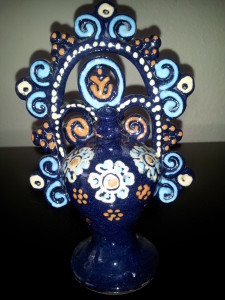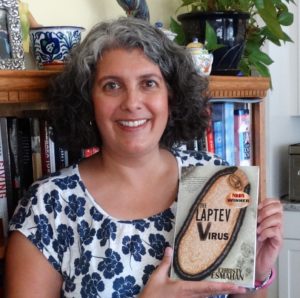Non-verbal communication, as we all know, is a huge part of how we interact with each other. A smiling “no” can be an invitation, while a morose “yes” should probably be considered a negative. But what about other gestures and sounds we make? I had not really paid much attention to how people communicate thoughts without words until I moved to Spain and found that besides lots of new vocabulary, I had to learn a rich assortment of non-spoken cues.
I often felt like an anthropologist when I lived in Spain. No, these Europeans were not some uncivilized tribe with whom I barely had anything in common. Al contrario. They were definitely first world and Western, and yet, there were gestures I had never seen and certainly did not know how to interpret. Learning them was a fun adventure, and eventually integrating them into my own body language helped me to really fit in. The first time I can remember puzzling over a gesture was on my way home from lab, one afternoon. Time was short and I had taken a bus rather than walking the 3 kilometers as I usually did. As I peered out the window I saw it: a hand raised, palm upward, fingers together and kept horizontally, held fairly close to the torso, perhaps at the level of the shoulders, and waved quickly back and forth. We were passing a park with a children’s jungle-gym playground, and there was a young woman, probably the mother of a four or five year old child, making this gesture to him. It was a brief glimpse, and the bus was already speeding away, so I didn’t get to see what it meant. A week later, I saw it again, in a restaurant: a father at a table made the same gesture to a squirming child. The child was about 7 and he reacted by pouting slightly, but then sitting up straighter. Then I saw it again in our university cafeteria: two of my friends were teasing each other and one of them did it to the other, adding the words, “a que te doy.” That I will give you. I was intrigued, and since everyone loved being my teacher, I decided to ask my friend and she explained that it meant something like “I’m gonna slap you if you don’t shape up.” Not, “that I will give you,” but rather, “if you don’t watch it, I’m going to give you [a slap].” I smiled and my friend smiled too, asking how an American would convey this thought.
Soon after this I learned another gesture which lots of my friends used when they were in heated conversations, usually about someone who had wronged them. “That so-and-so,” they would say, “she has some nerve,” and they would bring their hand to their face, fingers outstretched and held together and gently smack their own cheek. Sometimes they would turn their hand around and, fingers still all together, smack their cheek with the backs of their fingers. Both mean the same thing. Except, of course, they didn’t exactly say, “she has some nerve,” but rather, “what a hard face she has,” or “what a muzzle she has,” and hence the taping of the cheek. Sometimes they would even leave off the second part, saying only, “That so-and-so” and tap their cheek. Everyone (now including me) would understand what was meant. If you’re a soccer fan, keep an eye out when watching players from Spain–as soon as one of them feels wronged, you’ll see them quickly raise their hand to their cheek and smack it.
Another gesture, which is the equivalent of flipping someone off, is to raise your hand, bending it at the elbow, in a quick upward motion, keeping all fingers extended and together. One of my closest friends from college came to visit me once as she and her husband celebrated their ten year anniversary, and somehow we got on this subject and we discussed this hand gesture which, by this time, did actually feel like an insult to me, but to them it was a nonsensical motion. I laughed with them as she later told me that they had taken the gesture home and continually used it when they were teasing each other or pretending to be mad at the world. And this brought home the notion even more sharply that in order to truly speak another language, you must use your whole body to really convey the message, and that not knowing the gestures keeps you from fully understanding more subtle levels of meaning.
Making the “tsk” sound, by raising your tongue to the roof of your mouth and sucking in, is another very common gesture in Spain. It’s funny because even now, when I have a conversation with someone in Spanish, I very quickly return to using this sound to help me communicate. Here in the US we use it to scold someone as in, “Tsk, tsk, tsk, shame on you!” But in Spain, it’s a simple and unobtrusive “No.” Often it’s two ‘tsk’s’, as in, “Is this the book you wanted me to read?” answered by “Tsk, tsk.” But among close friends, the “no” is quickly reduced to a single “tsk.” It’s so easy and natural now, but I clearly remember having to learn and practice it.
If you want to say “There’s a ton of people” you hold your hand up, roughly to shoulder height, palm up then bring the tips of all your fingers and your thumb together, rapidly opening and closing them. If you want to say, “that costs a lot of money” you start with your hand in the same position, but now you rub your thumb against the pads of your fingers. And if you bring your index finger to your temple and then swiftly kick flick it away in a horizontal gesture, your saying that someone is crazy. And of course, the “hook-em-horns” sign that proud University of Texas students and alumni use means something totally different in Spain—it still refers to horns, but as in, “s/he is being cuckolded.” Yeah, not pretty. All four of my children are Longhorns, and I love UT, but I will admit it took me a while to be okay with their hand signal after all my years in Spain.
The list of gestures is much longer, of course, and I’m sure there are regional ones from different parts of Spain that I did not pick up on. But for the purposes of this post, I’ll leave you with one last one: reach up to your eye with just your index finger and place it on your lower eye-lid, gently and quickly yanking down just twice, while simultaneously raising your eyebrow. You’ve said, “I’m watching you,” though it can also mean, “Watch out,” or “be careful, that’s dangerous,” depending on the conversation, and you guessed it, the rest of the body language.
I found a cute Youtube video about Spanish gestures, some of which I did not mention in this blog.
What gestures have you noticed on your travels? Feel free to comment!
If you enjoyed this blog post, you might also like my series of novels, Bueno, Sinco and Brujas, which takes place in Santander, Spain.




2 comments
These blogs are so interesting. I could see them turned into another book, but about a young American student experiencing Spain!
Author
Thank you, Ruth, you might be right! It’s food for thought!